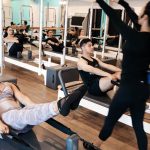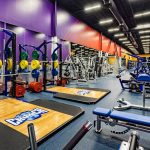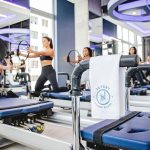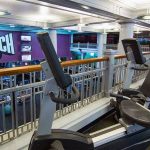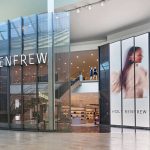Foot Locker, Inc. reported last week that, excluding net charges in both years, fourth quarter net income surged 56.4% to $61 million. Total sales increased 5.1% to $1.39 billion. Excluding the impact of currency fluctuations, sales advanced 6.5%. Comps increased 7.3%.
Reported GAAP net income, which includes certain one-time charges in both years, reached $57 million, or 36 cents a share, in the fourth quarter, compared to net earnings of $23 million, or 14 cents, in the prior-year period. The latest quarter included other income of $2 million, reflecting the partial cash recovery related to its investment in the reserve money market fund that Foot Looker was required to impair in 2008 when Lehman Brothers went bankrupt. It also included a non-cash impairment charge of $10 million related to CCS, the action sports e-commerce and catalog retailer acquired in 2008.

EPS was higher than internal expectations going into the quarter and slightly above Wall Street consensus estimates of 37 cents a share due to a strong gross margin rate increase, expense management and strong comps throughout most of the quarter, according to comments from Bob McHugh, Foot Locker's EVP and CFO, on a conference call with analysts. Comps softened in the U.S. during the last half of January, but that coincided with a strategic decision not to anniversary two promotional events run in late January last year in the U.S.
By month, comps increased high-single-digits in November and December and increased mid-single-digits in January.
By region, Foot Locker's combined U.S. store business generated a high-mid-single-digit comp store sales increase, which included a high-single-digit increase in apparel and accessories.
On the call, company Chairman and CEO Ken Hicks was particularly encouraged by the apparel increase, representing the fourth consecutive improvement on a quarterly sequential basis, although the category's margin still lags footwear.
“Over time we believe we have an opportunity to continue to increase our apparel margin and over the longer term for it to be stronger than footwear,” said Hicks. “While much progress has been made, much remains to be done. Developing a more compelling apparel assortment remains a key strategic priority for our company and one that we believe can be a significant sales and profit driver for our company over the long term.”
The U.S. footwear side was helped by efforts to bring in a broader range of athletic footwear and, in particular, improving its running assortment. Strong gains were seen in men's and kids’, led by player-endorsed marquee basketball, technical running, and lightweight running. Women's footwear was the “soft spot” domestically as it anniversaried strong toning sales last year.
“Toning shoes sales will likely remain challenging through the spring season of this year,” added Hicks. “While we no longer expect toning shoes to be a major growth opportunity, we do expect this category to remain an important part of our overall women's shoe business. In total, we do not expect the changes in our toning business to have a meaningful effect on our overall comparable store sales results.”
Average footwear selling prices in the U.S. increased high-mid-single digits for the quarter while unit sales were relatively flat. The increase in average selling prices reflects a continuing mix shift towards higher priced footwear and a lower markdown rate.
In Europe, comps increased in mid-single-digits and the division profit rate was up in the low-teens. Solid sales increases were generated in both men's and kids' footwear as well as a “very strong” increase in apparel, said Hicks. Canada recorded a mid-single-digit revenue comp gain along with a “solid” profit increase with a double-digit division margin rate. Asia-Pacific generated a low-single-digit comp increase in the quarter and a relatively flat profit comparison to last year.
The DotCom business delivered “an outstanding fourth-quarter result from both a sales and profit standpoint,” according to Hicks. Comps for the division increased double-digits and division profit margin reached the low-teens. Eastbay continued to generate the largest percentage of division sales and profits. However, Hicks added, “We believe that the most significant sales and profit growth opportunity for the division is to increase the penetration of online sales that are aligned with our store banners, building on our success of last year when we enjoyed strong double-digit sales growth from all of our dot-com store banners.”
Gross margin rate on a GAAP basis increased 320 basis points. On a non-GAAP basis, excluding a $14 million inventory write-down recorded last year, gross margins increased 210 basis points. That reflects a 120 basis point improvement in the merchandise margin rate, including increases in both footwear and apparel; and a 90 basis point improvement in its buying and occupancy rate.
The Foot Locker Inc. SG&A expense rate improved by 50 basis points to 21.8% of sales in Q4 despite increased incentive compensation accruals and planned additional marketing expenses.
Hicks said Foot Locker remains committed to CCS and plans to “devote additional time and resources to this business over the next 12 months and we strive to capitalize on this growth opportunity.” FL also plans to pursue growth by testing other new formats, including House of Hoops and RUN by Foot Locker.
Foot Locker ended the year with 3,426 owned stores. The world’s-largest-athletic-specialty retailer plans to open about 60 stores and close 55 in 2011. The resulting store count will be flat to increasing slightly “the first time in several years as we begin to accelerate our store openings and make our existing store fleet more profitable,” said Hicks. Europe was particularly cited as a region for accelerated expansion.
Looking to 2011, Foot Locker expects to generate a double-digit EPS increase versus last year's adjusted results based comps increasing low- to mid-single digits, its gross margin rate improving 30 to 50 basis points, its SG&A expenses growing 1% to 2% reflecting increased marketing costs, offset in part by lower incentive compensation accruals.
February comps were above plan in both the U.S. and Europe. As a result, it expects first-quarter sales, gross margin, and expense comparisons versus the first period of last year to be “somewhat more favorable” than its expected full-year guidance.











